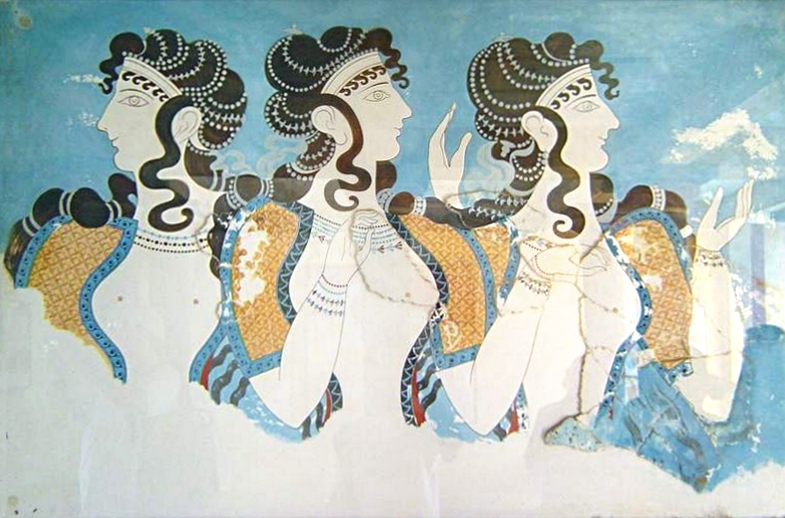I guess this is sort of an open question. Other than “buxom,” we have very little in the way of descriptions for Ariadne. Given her connections with the powerful Minoan Goddesses, and perhaps even Magna Mater Herself, I’m thinking that the commonly available depictions of her, which show her as smaller than Dionysos, are not particularly appropriate.
A Build Like Demeter
Hesiod, Theogony 947 ff (trans. Evelyn-White) (Greek epic C8th or C7th B.C.) :
“And golden-haired (khrysokomes) Dionysos made blonde-haired Ariadne, the daughter of Minos, his buxom ( θαλερὴν) wife: and [Zeus] the son of Kronos made her deathless and unageing for him.”
Thaleren, in short, in addition to having the connotations of vigorous, is often translated, in Homer and Hesiod, as “Buxom” or “sturdy” or even “stout.”

Whenever I look at Demeter, and regard her stature, one word inevitably comes to mind: “BAM.” This is one goddess you don’t mess around with. Who had Zeus willing to beg for mercy? Demeter had Zeus willing to beg for mercy. (Homeric Hymn to Demeter, #2)
She is powerfully built, not fat, but muscular. Look at those guns! What would you guess for a dress size? 14? Given her height, maybe a 16?
Here, we probably have a realistic goal for Ariadne’s build. She is no dainty little thing, I suspect, but instead, busty, muscular, and imposing.
I won’t lie to you and say that some part of me isn’t slightly motivated by modern politics. Obviously, in an era when having store mannequins in a size 8 is “condoning obesity” it is nice to be reminded that robust, healthy women can be quite a bit bigger.
A Crazy Cretan Hairdo and Naked Breasts

Here, in this picture, we get a flavor for what a Cretan Princess might wear on her head, and we see a little bit of Cretan fashion. It appears as though the blouses, while colorful, did not obscure the breasts, and we can see dainty nipples in this picture.

Here, again, we see that spectacular blouse which is cut specifically to support and expose the breasts.
Snakes and Knot-work
While we’re here, let’s talk about snakes for a bit, shall we?
This goddess, possibly called A-sa-sa-ra or A-sa-sa-ra-me by the Minoans (according to various interpretations of Linear A texts), who Barry B. Powell suggests was rendered into Greek mythology as Ariadne, is depicted in Minoan clothing, with a panther crown, snakes in her hands, and a sacral knot between her breasts.
The sacral knot resonates to Ariadne’s golden clew, a gift from the gods (at least in some renderings).
Walter Burkert comments, in his book _Greek Religion_ that snakes, in Minoan societies, were protectors of the home. In other nearby cultures, owing to their habit of shedding their skin, snakes are viewed as a symbol of renewal, and the Pelasgian myth of creation associates with the reborn dead.
Dionysos has, of course, some similar roles, being associated with death and rebirth. Curiously, there is a sacred knot reported to be associated with Dionysos as well: the Gordian knot. He is also associated with snakes visa vi Delphi. It seems fitting, therefore, that I should include the clew or sacral knot, in the image of his wife, and that, likewise, I should include snakes.
Olives
I’ll admit that this is more tenuous. However, Dionysos and Demeter, both vegetation deities in their own rights, are associated with death and rebirth in some fashion. In Demeter’s case, her daughter descends to Hades, and comes up again in the Spring. Dionysos descends, himself, to the Underworld, to retrieve Semele and Ariadne.
In this sense, we can see Ariadne as representing the vegetation itself. She, like the seeds, is interred, and then brought out again with new (in her case eternal) life. If this aspect is present in her diminished Greek form, and we know that she was exceedingly revered by the Minoans, we can infer some connection with the turning of seasons and the crops.
Lastly, the three major crops in Greece were barley, grapes and olives. Demeter has barley, Dionysos has the grapes. I’d like to draw Ariadne with olives.

Museum Collection: Toledo Museum of Art, Toledo, Ohio, USA
Catalogue Number: Toledo 1981.110
Beazley Archive Number: N/A
Ware: Lucanian Red Figure
Shape: Volute krater
Painter: Attributed to the Creusa Painter
Date: ca 380 – 360 BC
Period: Late Classical
But wait, what is this?
What do you say, ladies and gentlemen, is it a crown of laurel, or a crown of olives?
I think I can safely say that I have absolutely no idea, as yet, but that I am mightily tempted to see olive branches. This makes the image wonderful, in lieu of the mythology I discovered earlier, showing Dionysos waging war against the likes of Perseus. The war is over, and Dionysos is being crowned with olive branches, a symbol of peace, by his wife, Ariadne.
And in case you want to compare that object in her hands to some actual botanical specimens, for reference, I will include some below.


One comment